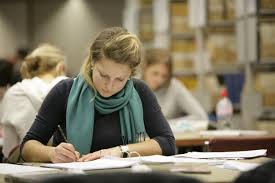Even before the inauguration of
the new location of
Goa State Central Library, there was talk about it. Persons
associated with the new building were giddy with excitement, asking in tones
that communicated they did not wish criticism, ‘Don’t you think it is
wonderful?’

This excitement however, has
perhaps to do with all the wrong reasons. There is
the almost childish excitement over all the gadgetry that has been employed in the new library
building and the marveling at the contemporary styling involved in the
façade-design of the building. This sort of adulation however may be missing
the wood for the trees. The Central Library was already a formidable
institution before it moved to its new location. Its stock of not just books,
but multi-lingual newspapers from the days of Portuguese sovereignty over the
territory, made it a place of pilgrimage for scholars from all across the
world. The imaginations of many a contemporary adult were fired through the
books made easily available at the Central Library. These are the fundamental
treasures and assets of the Central Library, and happily these seem to have now
been given a setting worthy of their value.

An earlier reflection in this
column worried about the manner in which the Central Library was being
displaced from the centre of the city to the margins of Panjim. Did this
reflect on our priorities vis-à-vis knowledge and learning, that column had
asked. Happily, it turns out that with the attention that has been lavished on
the library building, such fears could be for the moment put aside. Indeed,
given the manner that provisions in the new building seem to intersect with
plans for State libraries outside of the Panjim, it may well turn out that the
shifting of the library to the margin of the city, was not a shifting from the
centre to the periphery of our attention, but a shifting to reach out to the
often ignored peripheries of our State. If the new library with all its
gadgetry can respond to the intellectual demands of locations outside Panjim,
the shift would have been well worth it.

There is a grave danger to the
library however when the focus on the new building is placed on its gadgetry.
There is a peculiar Indian fascination for gadgets. Once obtained, and the
status value the gadgets promise is achieved, we conveniently forget about
them, and they rust or dust to death. We ought to be careful therefore where we
place our emphasis when evaluating the new infrastructure of the Central
Library. As mentioned above, our emphasis on the library must focus primarily
on its intellectual resources. However, there is also another resource that
power the earlier incarnation of the Central Library, and continues in the new,
its human resources. Anyone who has used the Central Library, both old and new,
will comment on the staff of the institution, who as a rule over-extend
themselves to address the regular users of the library. There ofcourse the
usual annoyances, when the librarians who ought to preside over the silence in
the library, are often at the root of the cacophony that can preside even on
the research floors of the library. Or the stray occasions, when students
timidly entering onto the research areas, are given a tongue-lashing that may
probably scar them away from research for the rest of their life. Despite these
regular incidents however, as a rule, the staff will go out of their way to
help. This has been a standard feature of the library, and happily the
augmentation of the staff, seems to have not changed this fact. To forget the
human resources of the library in a provincial fascination for technology would
be the single largest mistake with which to inaugurate the new location of the
Central Library.
 |
| Prasad Lolayekar & Carlos Fernandes |
What should perhaps also be
recognized however, is that in addition to the regular staff of the Library,
the Central Library is currently blessed not only with an extremely hospitable,
ever-listening, and eager-to-please Curator in the form of Carlos Fernandes,
but his energies are supplemented by the innovative and visionary energies of
the
Director of Art and Culture Prasad
Lolayekar. We should consider ourselves blessed to have them at the helm of
affairs. It appears that as a result of the synergies of these two men, and the
countless others they have consulted with, and the fact of consultation should
not be lightly dismissed, the Central Library is poised to reach out to ever
diverse segments of the Goan population.

One other significant manner in
which the Central Library has been augmented, is the inclusion of conference
halls, gallery space and theatre halls within its design. The conference halls
are an appropriate addition to a location that is not merely a lending library
but a significant research destination. Hopefully, this new addition, will
allow the Central Library to highlight its holdings, encourage a deeper engagement
with these texts, and who knows, engage in the publication of the discussions
and conferences held around these texts? Before all of that is done however,
one hopes that the newspapers in various languages, that are rapidly disintegrating,
will be speedily converted into digital format. We have waited for years now,
for this critical and long-delayed action to be effected, and this action
should now be undertaken post-haste, without further delay.

If the emphasis of this comment
on the new location of the Central Library has focused on the human resources
of the institution, then there is one last comment that needs to be made. In
keeping with the general sentiment of awe and wonder with which the new
location has been approached, there have been visitations organized for a
variety of groups, ranging from noisy students from primary schools, to
disinterested civil servants, and softly cooing visiting notables. If we are
serious about the Central Library reaching out to ever larger segments of users
(and we should bear in mind that this library is not merely a local treasure,
but in fact an internationally significant resource centre), then there is an
ever greater need to engage in some disciplinary actions with regard to our
interface with the Library. A library is not a show-case object that can be viewed
and appreciated. It is an object whose value and faults emerge in the course of
daily and repeated use. Rather than merely the walk through the park
introductions that are being given to young students therefore, perhaps there
should be a focus on initiating these younger students into the cult of silent
and patient pouring over the texts (now happily extended from print, into
visual and audio-visual) that this institution holds. Indeed, in the long run,
it is from the bowed and patient heads from inside the library that the most
useful critiques of our new library building will emerge. From the moment, and
from the outside, it appears that not enough is being done to encourage this
aspect of the library’s objective. This objective can however, be achieved only
through a more systematic, and long-term interaction between the Central
Library and the various higher-secondary schools and colleges that send their
students to the library. This objective will require the already pleasant
staff, to develop other skills; and it will require the Central Library to
develop nodes in other parts of the State, not limiting itself to the larger
towns of the territory.

To focus on the technological
additions to the Central Library, without appreciating its other assets would
be to seriously miss the point of the new location to the institution. The new
location of such a venerable institution offers Goan society a new start of
sorts, a start which no doubt has its short-comings, but a start for which we
should be grateful, and one we should seize to reimagine and rework our
society. For those who were responsible for all of this till date, a big thank
you.
(A version of this post was first published in the Gomantak Times dtd 2 May 2012)


No comments:
Post a Comment